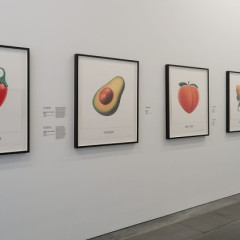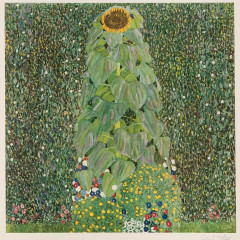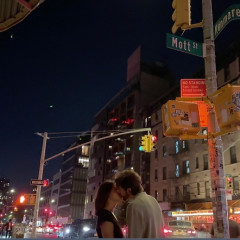Nelson Saiers: "Original Art Basel (Miami)" (2016)
_photo.jpg)
N. S.: The piece "Original Art Basel (Miami)" wrestles with mathematical beauty. Now, it does through the lens of the classic problem called the "Basel problem," which is named after the mathematician who solved its birth town—namely Leonhard Euler in Basel, Switzerland.
Now, in the foreground, colorful circles say the value of the Basel problem in Braille-based abstraction—namely π^2/6. The area of each of the circles represents one of the terms in the Basel problem. There are 13 circles, and the area of each of those circles represents one of the first 13 terms in the Basel problem. So if you think about it, what it's saying is that the area of the circles in the piece approximates the value they spell in Braille-based abstraction. Now, real quick, when I say "Braille-based abstraction." What I mean by that is that if you shrink all the circles down to the same size, it would say π^2/6 in Braille; which, as I said, is a solution to the Basel problem.
Now, the equations and words that surround the piece; they reference the Basel problem (or aspects of it) and also some of the work on its successor, namely the Zeta function. Now, the choice of Braille—why? Two reasons. The first motivation that comes from Euler himself who had eye problems, which eventually led to him going blind midway through his life. The second thing really hints at a painter, who is recognized as the Father of Abstract Art, Wassily Kandinsky, combined with a description of mathematics. It's hard to generalize mathematics; but, on the one hand, you can think of a mathematical equation as a rigorous abstract statement. In the case of something like the Basel problem, which took a century to solve and stumped some of the greatest minds in mathematics, the solution to these abstract questions are hard to see. And so, to represent that, I chose an image that Kandinsky would use—which is circles. And I spell the answer to the Basel problem in circular imagery that's based on Braille....It's hard to generalize, but you could think of mathematics as an abstract truth statement. And good mathematics is an abstract truth statement whose value is hard to see—like the Basel problem.
Finally, the colors point to colors that are typically associated with Miami. Hence, "Original Art Basel (Miami)."
[Photo courtesy of Nelson Saiers]


.jpg)
.jpg)



.jpg)
.jpg)
.jpg)




